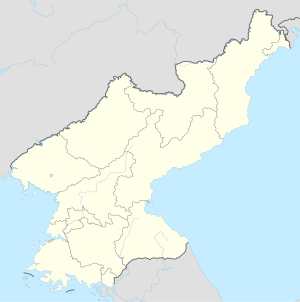Sinŭiju
| Sinŭiju | |||
|---|---|---|---|
| Korean alphabet : | 신의주 시 | ||
| Chinese characters : | 新 義 州市 | ||
| Revised Romanization : | Sinuiju-si | ||
| McCune-Reischauer : | Sinŭiju-si | ||
| Basic data | |||
| Province : | P'yŏngan-pukto | ||
| Coordinates : | 40 ° 6 ′ N , 124 ° 24 ′ E | ||
| Residents: | 359,341 (as of 2008) | ||
| Structure: | 49 boroughs ( dong ); 9 rural districts ( Ri ) |
||
| map | |||
|
|||

Sinŭiju is a city in North Korea with 359,341 inhabitants. It is the capital of the P'yŏngan-pukto province and a cultural center with universities , colleges , theaters and museums .
geography
Geographical location
The city lies on the border with the People's Republic of China on the Yalu (Amrok-kang) river, which flows into the Korean Bay between Dandong in China and Sinŭiju .
The city's average level is seven meters above sea level . The geographical coordinates are 40.10 degrees north and 124.41 degrees east.
The districts of Ŭiju, P'ihyŏn and Ryongch'ŏn border the urban area.
climate
|
Average monthly temperatures and rainfall for Sinŭiju
Source: wetterkontor.de
|
|||||||||||||||||||||||||||||||||||||||||||||||||||||||||||||||||||||||||||||||||||||||||||||||||||||||||||||||||||||||||||||||||||||||
Sinŭiju is located in the temperate climate zone . The average annual temperature is 9.4 degrees Celsius and the annual rainfall is 1,043 millimeters. The warmest month is August with an average of 24.1 degrees Celsius, the coldest is January with an average of −7.2 degrees Celsius. Most of the precipitation falls in July with an average of 313 millimeters, the lowest in December and February with an average of 15 millimeters.
history
Sinŭiju came under Japanese rule in 1904 after the Battle of Yalu in the Russo-Japanese War . Since the complete incorporation of Korea into the Japanese Empire in 1910 until its independence in 1945, Japanese was the official language. As a result, the city name Shingishū ( 新 義 州 ) was read. During this time, the importance of the city grew after a railway bridge was built over the Amrokgang in 1910 , which connected Shingishū with what was then Andong . This was later supplemented by a second bridge that the Japanese colonial administration had built sixty meters upriver from April 1937 to May 1943. As early as 1924, the Japanese colonial administration of Heian-hokudō was relocated from Gishū ( 義 州 ), about ten kilometers away, to Shingishū.
During the Korean War (1950–1953) the city suffered severe devastation. In an air raid on November 10, 1950, 79 American B-29 bombers a. a. dropped more than 500 tons of incendiary bombs on Sinŭiju. The city was almost completely destroyed. After the war, Sinŭiju developed into an industrial location and transport hub in the region.
Culture and sights
The summer house Tonggunjeong, which was used by the military of the Goryeo dynasty (918–1392) as a lookout point, is well worth seeing . Its festive design is remarkable.
Next to the train station is Kim Il sung Square . In the northeast of the chessboard-like city there are government offices and residences as well as an industrial area on the Amrokgang River.
Economy and Infrastructure
economy
Sinŭiju is an industrial city with light , paper and textile industries . The urban area is part of a special economic zone that has been proclaimed since 2002 (see Special Administrative Region Sinŭiju ), which is intended to serve free trade. In this context z. For example, the then joint venture Hana Electronics had an office in Sinŭiju.
Below the Sino-Korean Friendship Bridge , a 130,000 m² “tourist zone” was opened in December 2015, especially for day visitors from China. Up to 10,000 visitors who do not need a passport for this form of entry are expected to visit the site on the riverbank. a. be entertained by shops as well as a theater. The project was financed by the "Dandong International Travel Agency of China".
traffic
The city is a traffic junction with roads, a rail link to the capital Pyongyang and a port opened in 1910. In 1906 the Siniju train station opened . Dandong and Sinŭiju are linked by the Sino-Korean Friendship Bridge, which is only used by motor vehicles and railways. A New Yalu Bridge over the Yalu, financed and built by China , has not been opened since its completion in 2014, as the transport connection on the Korean side has not yet been implemented. The Pyongyang – Siniju Expressway and the Pyongyang – Sinŭiju Railway are under construction. Siniju Airport is located in the south of the city . In public transport since the late 1970s come trolleybuses used.
education
There are two universities and several colleges and technical colleges in the city. Educational institutions and buildings of the city administration and the state government are located on Toch'ŏng Street.
Sports
The five-time North Korean soccer champion Lokomotive Sinŭiju plays his home games in the Sinŭiju Stadium .
Web links
- Rainer Dormels: Sinuiju - Korea's gateway to the Eurasian mainland , 2014 (PDF; 835 kB)
Footnotes
- ↑ Central Bureau of Statistics (ed.): DPR Korea 2008 Population Census - National Report . Pyongyang 2009, p. 26 ( online [PDF; accessed December 27, 2014]).
- ^ Phoenix Commercial Ventures update . On nkeconwatch.com on July 8, 2011
- ↑ Sinuiju-River Amnok Tourist Zone of DPRK opened to visitors . On nkeconwatch.com on December 24, 2015







